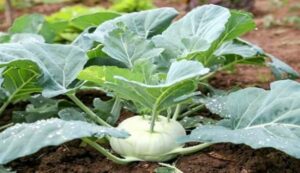Farmers will benefit from growing Knot Cabbage, know the method of cultivation
Knot Cabbage Cultivation: Cauliflower and cabbage are the two types that most people think of when they think about cabbage. However, one of its types is also Knot Cabbage, which is nutrient-dense and smaller than cauliflower and cabbage. In India, cabbage is referred to by a variety of names, including Kohl Rabi, Gandh Cabbage, Knol Khol, and Cabbage Turnip. Grown in Kashmir, Maharashtra, Bengal, Assam, Uttar Pradesh, Bihar, and Punjab, it is an autumn vegetable.

Know all the necessary details about growing cabbage
An ideal environment
The best conditions for growing knot cabbage are said to be cool and damp. Bolting is an issue that early cultivars of the plant face in temperate climates, although it is less of an issue in subtropical climates. The ideal temperature range for growing knot cabbage is said to be between 24 and 45 degrees Celsius. Additionally, the average monthly temperature is between 15 and 20 degrees Celsius.
Adequate soil
Although cauliflower may be grown in a variety of soil types, heavy loamy soil with good drainage is said to be the best. It may also be grown on soil with a pH of 6.5 to 7.0. The field for cauliflower is prepared similarly to the field for cauliflower.
More sophisticated types
Although there are many sophisticated cauliflower cultivars accessible worldwide, the majority of the kinds grown in the nation are imported. King of North, Large Green, White Vienna, and Purple Vienna are regarded as the main types in India.
Fertilizers and manure
Only after doing soil testing can farmers apply fertilizers to the cauliflower crop. 20 to 25 tonnes of cow dung or compost manure, 100 to 120 kg of nitrogen, 80 kg of phosphorus, and 80 kg of potash should be applied per acre in order to maximize the crop’s production. Half of the nitrogen, all of the phosphorus, and all of the potash should be well incorporated into the soil before the last plowing.
Time to sow
In the plains, August through October is said to be the ideal time of year to plant knotted cabbage. It is planted in the central areas between July and October. In addition, knotted cabbage is seeded from March to July on the higher elevations.
Management of irrigation
In knots Proper irrigation is necessary for the cabbage crop; it should be watered every 10 to 15 days. When knots develop in the crop, the irrigation interval may alter, which causes the cabbage to start becoming tough since it isn’t being irrigated at the proper moment. In addition, farmers are afraid that the knots would explode because of their rapid development.
Maximum yield of 240 quintals
Numerous factors, including crop management, temperature, cultivars, and soil fertility, affect the production of knotted cabbage. On the other hand, the yield has significantly risen when comparing the early variety to the previously mentioned types. Approximately 200 to 240 quintals of cabbage may be produced by farmers using a one-hectare area.

